Pliny the Elder: A Discussion on the Life and Accomplishments of the Horticulturist Scientist
VerifiedAdded on 2023/06/03
|7
|1536
|329
AI Summary
This project discusses the life and major accomplishments of Pliny the Elder, a horticulturist scientist in the Roman Empire. It evaluates his contributions to botany, medicine, technology, and more.
Contribute Materials
Your contribution can guide someone’s learning journey. Share your
documents today.
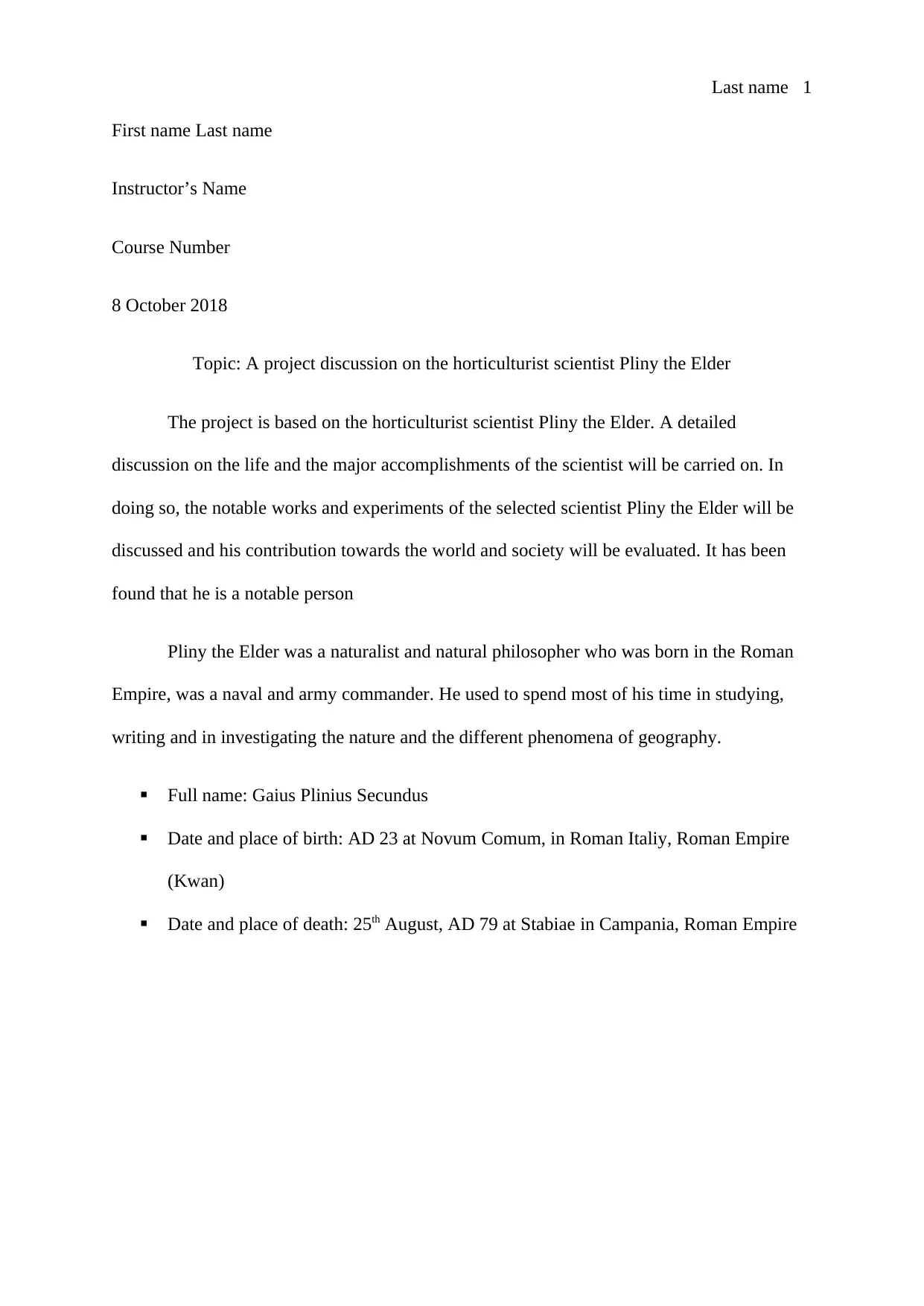
Last name 1
First name Last name
Instructor’s Name
Course Number
8 October 2018
Topic: A project discussion on the horticulturist scientist Pliny the Elder
The project is based on the horticulturist scientist Pliny the Elder. A detailed
discussion on the life and the major accomplishments of the scientist will be carried on. In
doing so, the notable works and experiments of the selected scientist Pliny the Elder will be
discussed and his contribution towards the world and society will be evaluated. It has been
found that he is a notable person
Pliny the Elder was a naturalist and natural philosopher who was born in the Roman
Empire, was a naval and army commander. He used to spend most of his time in studying,
writing and in investigating the nature and the different phenomena of geography.
Full name: Gaius Plinius Secundus
Date and place of birth: AD 23 at Novum Comum, in Roman Italiy, Roman Empire
(Kwan)
Date and place of death: 25th August, AD 79 at Stabiae in Campania, Roman Empire
First name Last name
Instructor’s Name
Course Number
8 October 2018
Topic: A project discussion on the horticulturist scientist Pliny the Elder
The project is based on the horticulturist scientist Pliny the Elder. A detailed
discussion on the life and the major accomplishments of the scientist will be carried on. In
doing so, the notable works and experiments of the selected scientist Pliny the Elder will be
discussed and his contribution towards the world and society will be evaluated. It has been
found that he is a notable person
Pliny the Elder was a naturalist and natural philosopher who was born in the Roman
Empire, was a naval and army commander. He used to spend most of his time in studying,
writing and in investigating the nature and the different phenomena of geography.
Full name: Gaius Plinius Secundus
Date and place of birth: AD 23 at Novum Comum, in Roman Italiy, Roman Empire
(Kwan)
Date and place of death: 25th August, AD 79 at Stabiae in Campania, Roman Empire
Secure Best Marks with AI Grader
Need help grading? Try our AI Grader for instant feedback on your assignments.
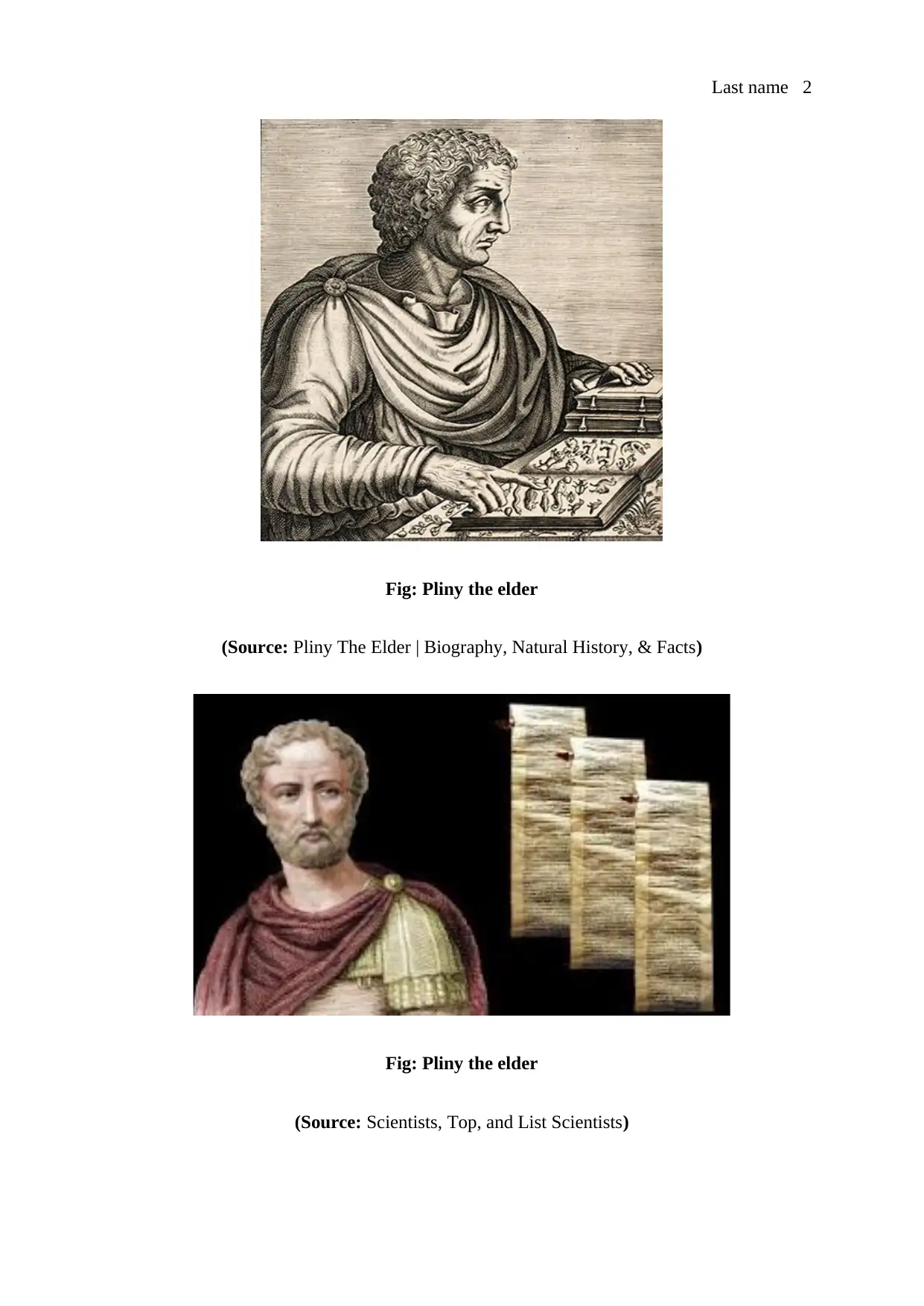
Last name 2
Fig: Pliny the elder
(Source: Pliny The Elder | Biography, Natural History, & Facts)
Fig: Pliny the elder
(Source: Scientists, Top, and List Scientists)
Fig: Pliny the elder
(Source: Pliny The Elder | Biography, Natural History, & Facts)
Fig: Pliny the elder
(Source: Scientists, Top, and List Scientists)
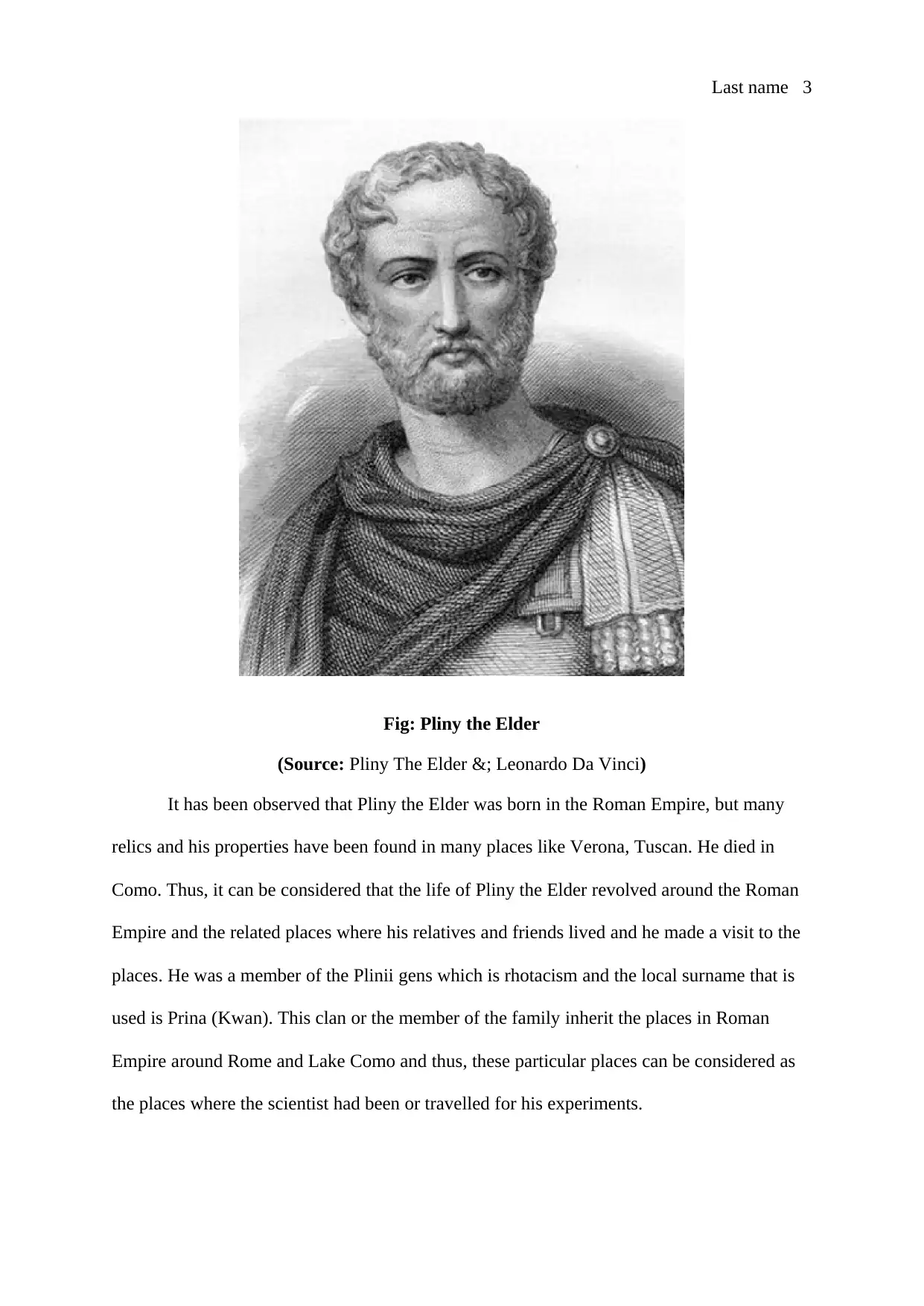
Last name 3
Fig: Pliny the Elder
(Source: Pliny The Elder &; Leonardo Da Vinci)
It has been observed that Pliny the Elder was born in the Roman Empire, but many
relics and his properties have been found in many places like Verona, Tuscan. He died in
Como. Thus, it can be considered that the life of Pliny the Elder revolved around the Roman
Empire and the related places where his relatives and friends lived and he made a visit to the
places. He was a member of the Plinii gens which is rhotacism and the local surname that is
used is Prina (Kwan). This clan or the member of the family inherit the places in Roman
Empire around Rome and Lake Como and thus, these particular places can be considered as
the places where the scientist had been or travelled for his experiments.
Fig: Pliny the Elder
(Source: Pliny The Elder &; Leonardo Da Vinci)
It has been observed that Pliny the Elder was born in the Roman Empire, but many
relics and his properties have been found in many places like Verona, Tuscan. He died in
Como. Thus, it can be considered that the life of Pliny the Elder revolved around the Roman
Empire and the related places where his relatives and friends lived and he made a visit to the
places. He was a member of the Plinii gens which is rhotacism and the local surname that is
used is Prina (Kwan). This clan or the member of the family inherit the places in Roman
Empire around Rome and Lake Como and thus, these particular places can be considered as
the places where the scientist had been or travelled for his experiments.
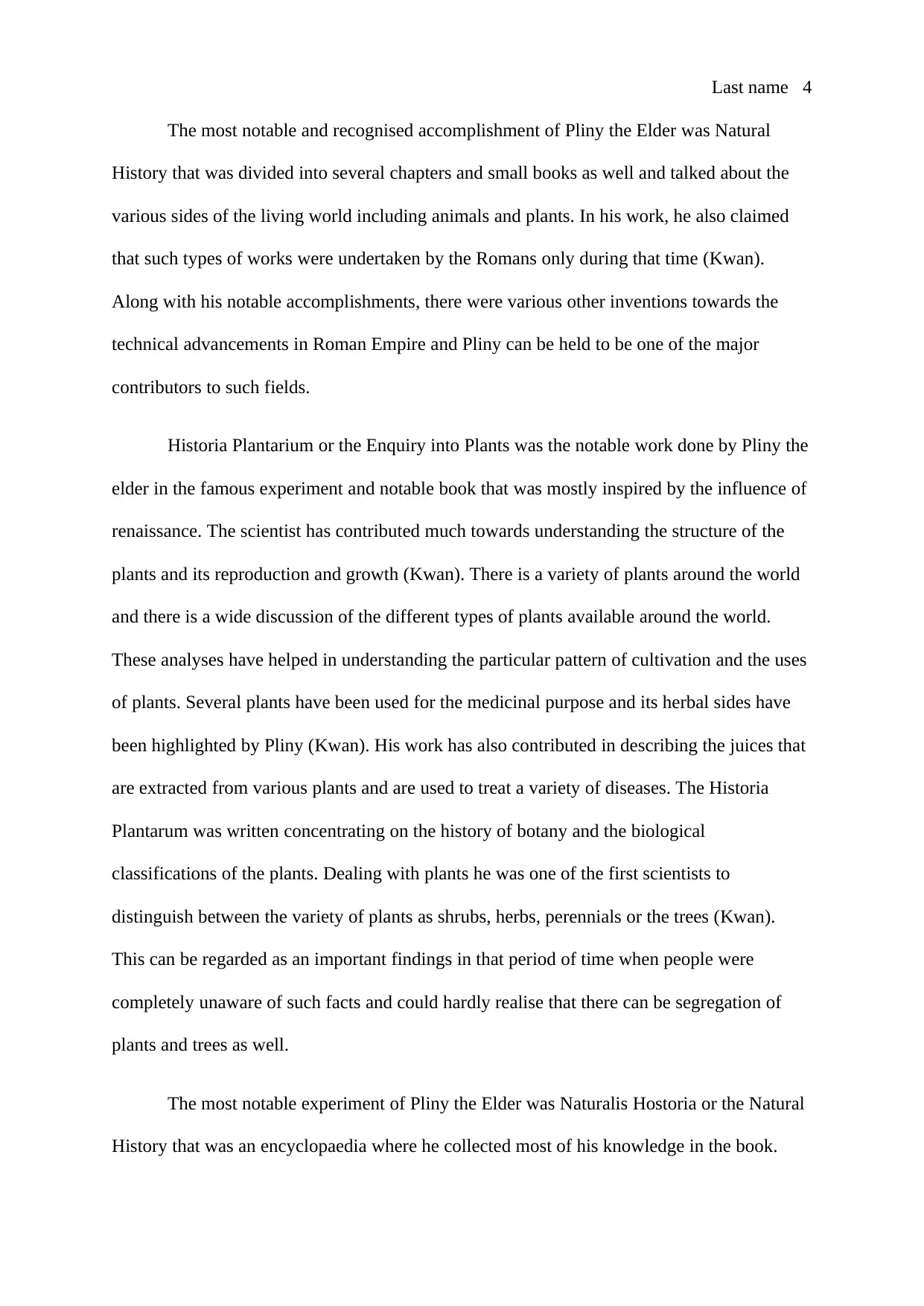
Last name 4
The most notable and recognised accomplishment of Pliny the Elder was Natural
History that was divided into several chapters and small books as well and talked about the
various sides of the living world including animals and plants. In his work, he also claimed
that such types of works were undertaken by the Romans only during that time (Kwan).
Along with his notable accomplishments, there were various other inventions towards the
technical advancements in Roman Empire and Pliny can be held to be one of the major
contributors to such fields.
Historia Plantarium or the Enquiry into Plants was the notable work done by Pliny the
elder in the famous experiment and notable book that was mostly inspired by the influence of
renaissance. The scientist has contributed much towards understanding the structure of the
plants and its reproduction and growth (Kwan). There is a variety of plants around the world
and there is a wide discussion of the different types of plants available around the world.
These analyses have helped in understanding the particular pattern of cultivation and the uses
of plants. Several plants have been used for the medicinal purpose and its herbal sides have
been highlighted by Pliny (Kwan). His work has also contributed in describing the juices that
are extracted from various plants and are used to treat a variety of diseases. The Historia
Plantarum was written concentrating on the history of botany and the biological
classifications of the plants. Dealing with plants he was one of the first scientists to
distinguish between the variety of plants as shrubs, herbs, perennials or the trees (Kwan).
This can be regarded as an important findings in that period of time when people were
completely unaware of such facts and could hardly realise that there can be segregation of
plants and trees as well.
The most notable experiment of Pliny the Elder was Naturalis Hostoria or the Natural
History that was an encyclopaedia where he collected most of his knowledge in the book.
The most notable and recognised accomplishment of Pliny the Elder was Natural
History that was divided into several chapters and small books as well and talked about the
various sides of the living world including animals and plants. In his work, he also claimed
that such types of works were undertaken by the Romans only during that time (Kwan).
Along with his notable accomplishments, there were various other inventions towards the
technical advancements in Roman Empire and Pliny can be held to be one of the major
contributors to such fields.
Historia Plantarium or the Enquiry into Plants was the notable work done by Pliny the
elder in the famous experiment and notable book that was mostly inspired by the influence of
renaissance. The scientist has contributed much towards understanding the structure of the
plants and its reproduction and growth (Kwan). There is a variety of plants around the world
and there is a wide discussion of the different types of plants available around the world.
These analyses have helped in understanding the particular pattern of cultivation and the uses
of plants. Several plants have been used for the medicinal purpose and its herbal sides have
been highlighted by Pliny (Kwan). His work has also contributed in describing the juices that
are extracted from various plants and are used to treat a variety of diseases. The Historia
Plantarum was written concentrating on the history of botany and the biological
classifications of the plants. Dealing with plants he was one of the first scientists to
distinguish between the variety of plants as shrubs, herbs, perennials or the trees (Kwan).
This can be regarded as an important findings in that period of time when people were
completely unaware of such facts and could hardly realise that there can be segregation of
plants and trees as well.
The most notable experiment of Pliny the Elder was Naturalis Hostoria or the Natural
History that was an encyclopaedia where he collected most of his knowledge in the book.
Secure Best Marks with AI Grader
Need help grading? Try our AI Grader for instant feedback on your assignments.
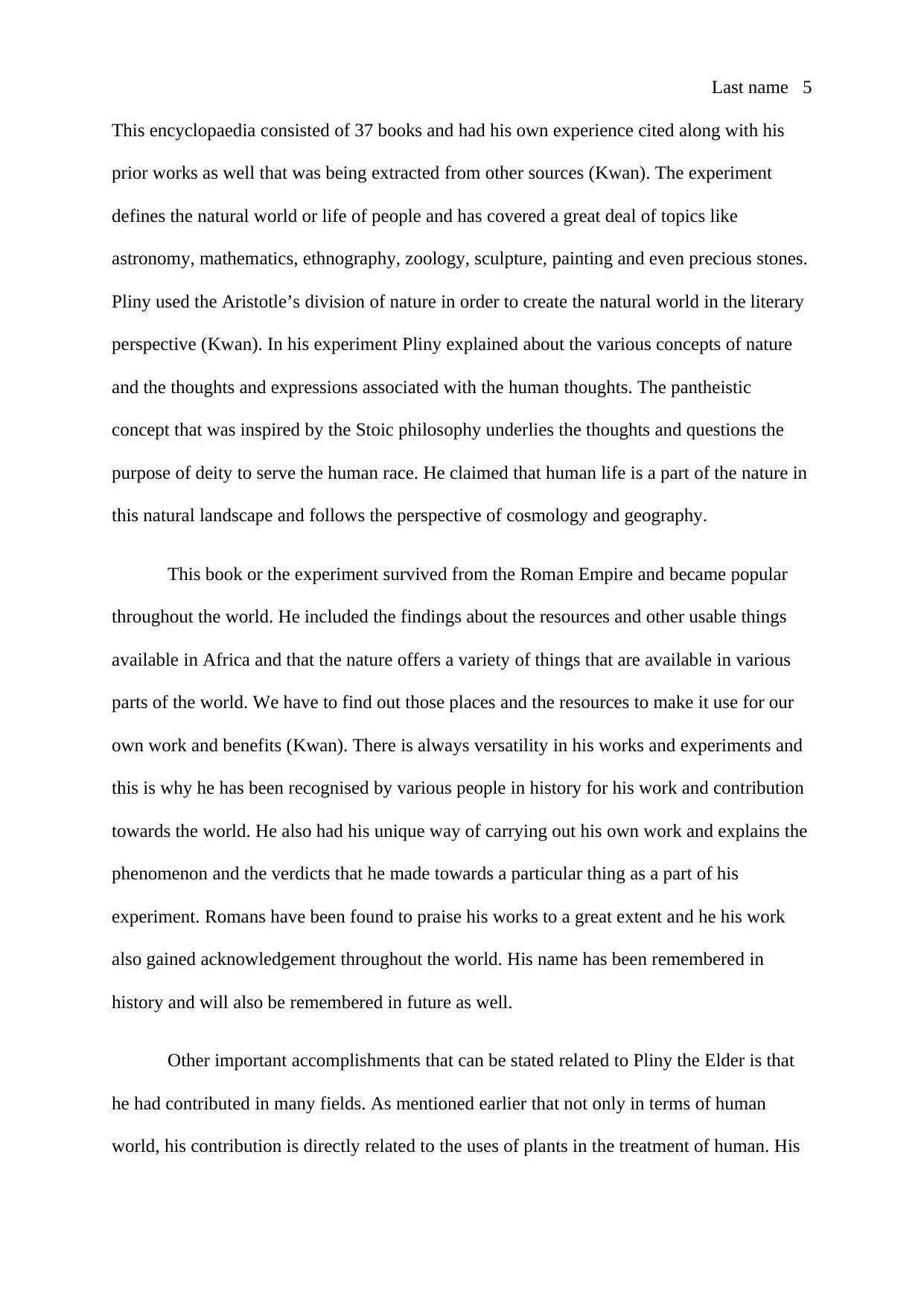
Last name 5
This encyclopaedia consisted of 37 books and had his own experience cited along with his
prior works as well that was being extracted from other sources (Kwan). The experiment
defines the natural world or life of people and has covered a great deal of topics like
astronomy, mathematics, ethnography, zoology, sculpture, painting and even precious stones.
Pliny used the Aristotle’s division of nature in order to create the natural world in the literary
perspective (Kwan). In his experiment Pliny explained about the various concepts of nature
and the thoughts and expressions associated with the human thoughts. The pantheistic
concept that was inspired by the Stoic philosophy underlies the thoughts and questions the
purpose of deity to serve the human race. He claimed that human life is a part of the nature in
this natural landscape and follows the perspective of cosmology and geography.
This book or the experiment survived from the Roman Empire and became popular
throughout the world. He included the findings about the resources and other usable things
available in Africa and that the nature offers a variety of things that are available in various
parts of the world. We have to find out those places and the resources to make it use for our
own work and benefits (Kwan). There is always versatility in his works and experiments and
this is why he has been recognised by various people in history for his work and contribution
towards the world. He also had his unique way of carrying out his own work and explains the
phenomenon and the verdicts that he made towards a particular thing as a part of his
experiment. Romans have been found to praise his works to a great extent and he his work
also gained acknowledgement throughout the world. His name has been remembered in
history and will also be remembered in future as well.
Other important accomplishments that can be stated related to Pliny the Elder is that
he had contributed in many fields. As mentioned earlier that not only in terms of human
world, his contribution is directly related to the uses of plants in the treatment of human. His
This encyclopaedia consisted of 37 books and had his own experience cited along with his
prior works as well that was being extracted from other sources (Kwan). The experiment
defines the natural world or life of people and has covered a great deal of topics like
astronomy, mathematics, ethnography, zoology, sculpture, painting and even precious stones.
Pliny used the Aristotle’s division of nature in order to create the natural world in the literary
perspective (Kwan). In his experiment Pliny explained about the various concepts of nature
and the thoughts and expressions associated with the human thoughts. The pantheistic
concept that was inspired by the Stoic philosophy underlies the thoughts and questions the
purpose of deity to serve the human race. He claimed that human life is a part of the nature in
this natural landscape and follows the perspective of cosmology and geography.
This book or the experiment survived from the Roman Empire and became popular
throughout the world. He included the findings about the resources and other usable things
available in Africa and that the nature offers a variety of things that are available in various
parts of the world. We have to find out those places and the resources to make it use for our
own work and benefits (Kwan). There is always versatility in his works and experiments and
this is why he has been recognised by various people in history for his work and contribution
towards the world. He also had his unique way of carrying out his own work and explains the
phenomenon and the verdicts that he made towards a particular thing as a part of his
experiment. Romans have been found to praise his works to a great extent and he his work
also gained acknowledgement throughout the world. His name has been remembered in
history and will also be remembered in future as well.
Other important accomplishments that can be stated related to Pliny the Elder is that
he had contributed in many fields. As mentioned earlier that not only in terms of human
world, his contribution is directly related to the uses of plants in the treatment of human. His
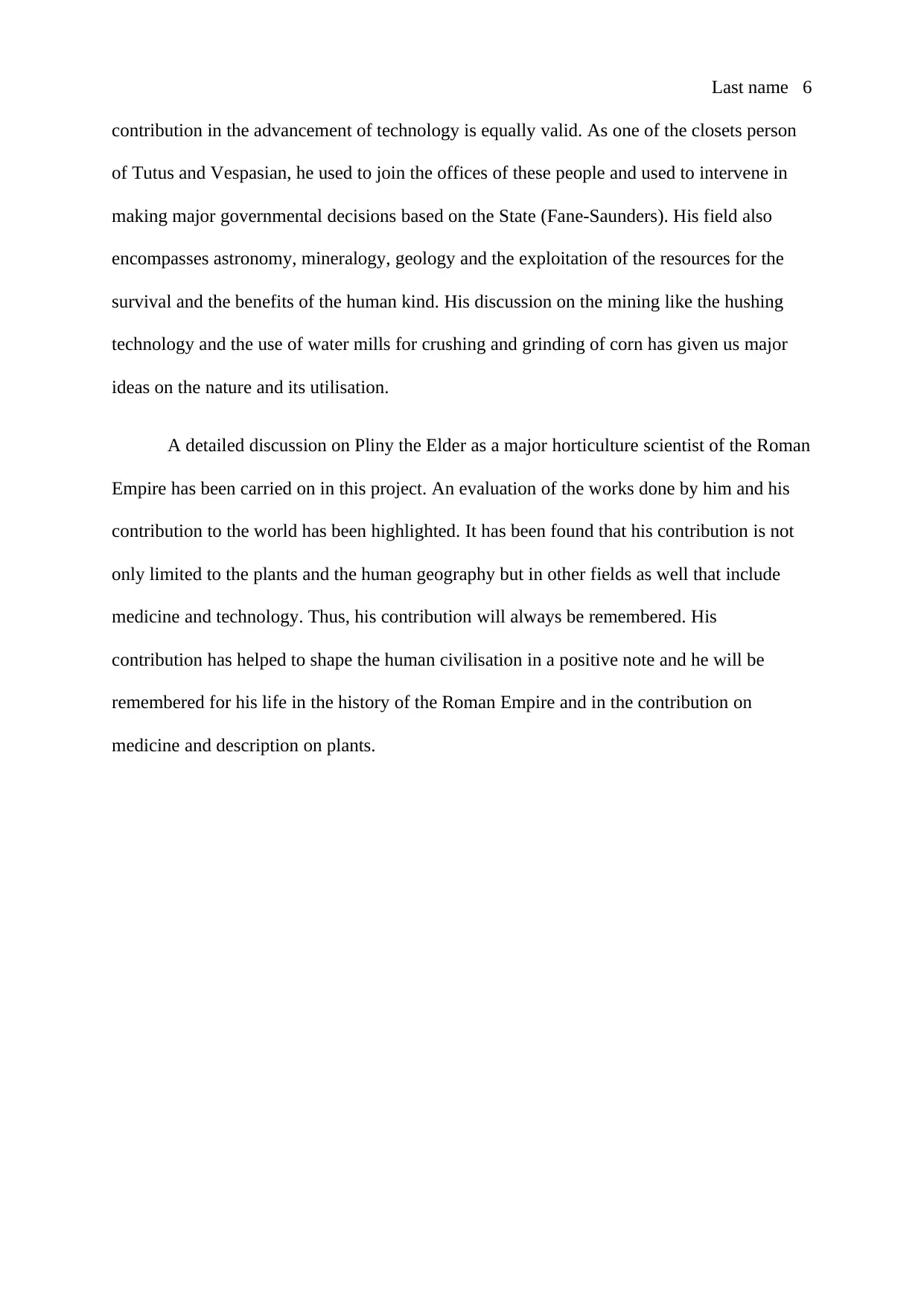
Last name 6
contribution in the advancement of technology is equally valid. As one of the closets person
of Tutus and Vespasian, he used to join the offices of these people and used to intervene in
making major governmental decisions based on the State (Fane-Saunders). His field also
encompasses astronomy, mineralogy, geology and the exploitation of the resources for the
survival and the benefits of the human kind. His discussion on the mining like the hushing
technology and the use of water mills for crushing and grinding of corn has given us major
ideas on the nature and its utilisation.
A detailed discussion on Pliny the Elder as a major horticulture scientist of the Roman
Empire has been carried on in this project. An evaluation of the works done by him and his
contribution to the world has been highlighted. It has been found that his contribution is not
only limited to the plants and the human geography but in other fields as well that include
medicine and technology. Thus, his contribution will always be remembered. His
contribution has helped to shape the human civilisation in a positive note and he will be
remembered for his life in the history of the Roman Empire and in the contribution on
medicine and description on plants.
contribution in the advancement of technology is equally valid. As one of the closets person
of Tutus and Vespasian, he used to join the offices of these people and used to intervene in
making major governmental decisions based on the State (Fane-Saunders). His field also
encompasses astronomy, mineralogy, geology and the exploitation of the resources for the
survival and the benefits of the human kind. His discussion on the mining like the hushing
technology and the use of water mills for crushing and grinding of corn has given us major
ideas on the nature and its utilisation.
A detailed discussion on Pliny the Elder as a major horticulture scientist of the Roman
Empire has been carried on in this project. An evaluation of the works done by him and his
contribution to the world has been highlighted. It has been found that his contribution is not
only limited to the plants and the human geography but in other fields as well that include
medicine and technology. Thus, his contribution will always be remembered. His
contribution has helped to shape the human civilisation in a positive note and he will be
remembered for his life in the history of the Roman Empire and in the contribution on
medicine and description on plants.
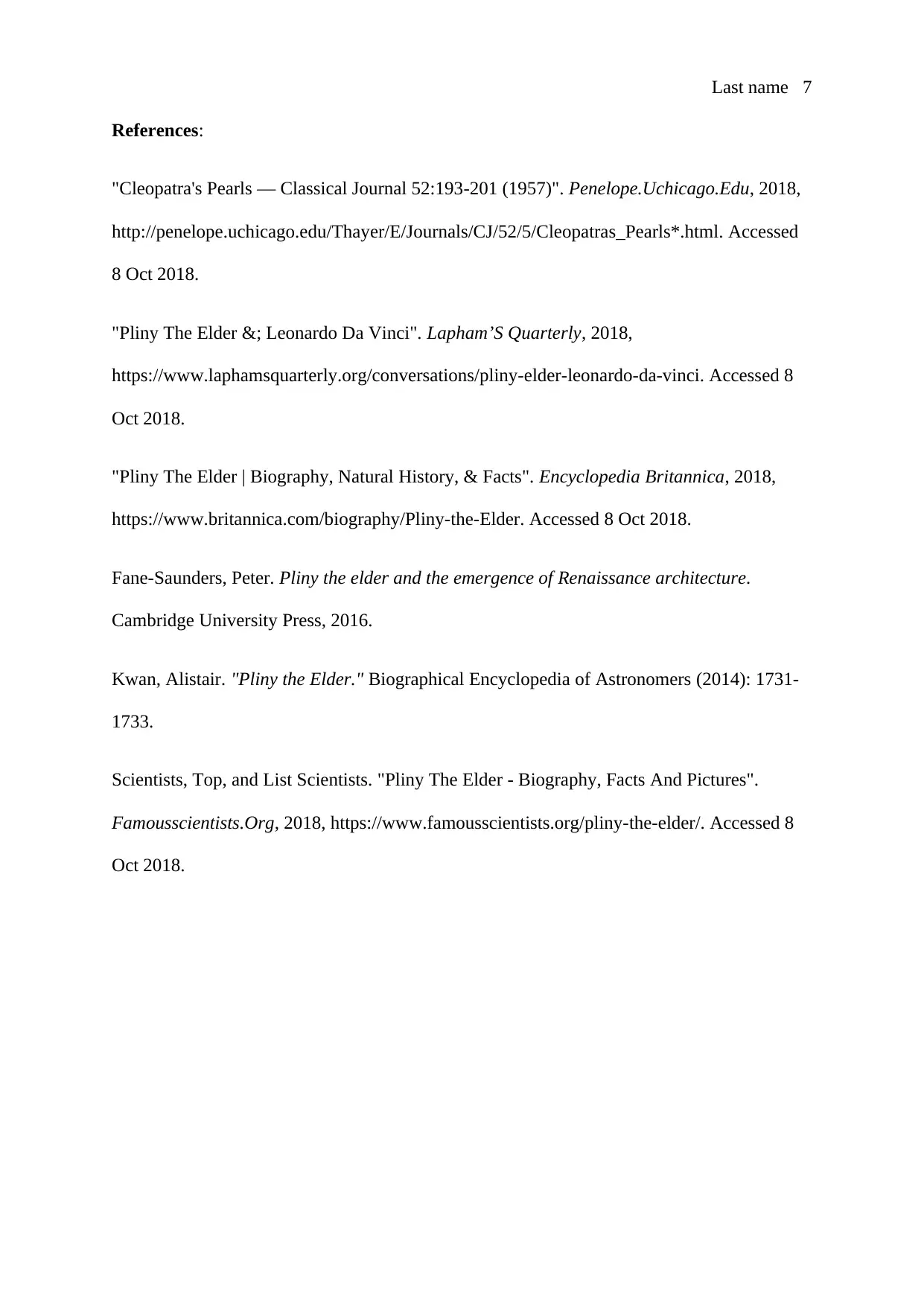
Last name 7
References:
"Cleopatra's Pearls — Classical Journal 52:193-201 (1957)". Penelope.Uchicago.Edu, 2018,
http://penelope.uchicago.edu/Thayer/E/Journals/CJ/52/5/Cleopatras_Pearls*.html. Accessed
8 Oct 2018.
"Pliny The Elder &; Leonardo Da Vinci". Lapham’S Quarterly, 2018,
https://www.laphamsquarterly.org/conversations/pliny-elder-leonardo-da-vinci. Accessed 8
Oct 2018.
"Pliny The Elder | Biography, Natural History, & Facts". Encyclopedia Britannica, 2018,
https://www.britannica.com/biography/Pliny-the-Elder. Accessed 8 Oct 2018.
Fane-Saunders, Peter. Pliny the elder and the emergence of Renaissance architecture.
Cambridge University Press, 2016.
Kwan, Alistair. "Pliny the Elder." Biographical Encyclopedia of Astronomers (2014): 1731-
1733.
Scientists, Top, and List Scientists. "Pliny The Elder - Biography, Facts And Pictures".
Famousscientists.Org, 2018, https://www.famousscientists.org/pliny-the-elder/. Accessed 8
Oct 2018.
References:
"Cleopatra's Pearls — Classical Journal 52:193-201 (1957)". Penelope.Uchicago.Edu, 2018,
http://penelope.uchicago.edu/Thayer/E/Journals/CJ/52/5/Cleopatras_Pearls*.html. Accessed
8 Oct 2018.
"Pliny The Elder &; Leonardo Da Vinci". Lapham’S Quarterly, 2018,
https://www.laphamsquarterly.org/conversations/pliny-elder-leonardo-da-vinci. Accessed 8
Oct 2018.
"Pliny The Elder | Biography, Natural History, & Facts". Encyclopedia Britannica, 2018,
https://www.britannica.com/biography/Pliny-the-Elder. Accessed 8 Oct 2018.
Fane-Saunders, Peter. Pliny the elder and the emergence of Renaissance architecture.
Cambridge University Press, 2016.
Kwan, Alistair. "Pliny the Elder." Biographical Encyclopedia of Astronomers (2014): 1731-
1733.
Scientists, Top, and List Scientists. "Pliny The Elder - Biography, Facts And Pictures".
Famousscientists.Org, 2018, https://www.famousscientists.org/pliny-the-elder/. Accessed 8
Oct 2018.
1 out of 7
Related Documents
Your All-in-One AI-Powered Toolkit for Academic Success.
+13062052269
info@desklib.com
Available 24*7 on WhatsApp / Email
![[object Object]](/_next/static/media/star-bottom.7253800d.svg)
Unlock your academic potential
© 2024 | Zucol Services PVT LTD | All rights reserved.
